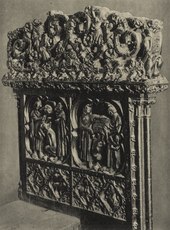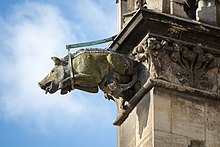
Cologne Cathedral is a Catholic cathedral in Cologne, North Rhine-Westphalia. It is the seat of the Archbishop of Cologne and of the administration of the Archdiocese of Cologne. It is a renowned monument of German Catholicism and Gothic architecture and was declared a World Heritage Site in 1996. It is Germany's most visited landmark, attracting an average of 20,000 people a day. At 157 m (515 ft), the cathedral is the tallest twin-spired church in the world, the second tallest church in Europe after Ulm Minster, and the third tallest church of any kind in the world. It is the largest Gothic church in Northern Europe and has the second-tallest spires. The towers for its two huge spires give the cathedral the largest façade of any church in the world. The choir has the largest height-to-width ratio, 3.6:1, of any medieval church.

Aachen Cathedral is a Roman Catholic church in Aachen, Germany and the seat of the Roman Catholic Diocese of Aachen.
A Judensau is a folk art image of Jews in obscene contact with a large sow, which in Judaism is an unclean animal, that appeared during the 13th century in Germany and some other European countries; its popularity lasted for over 600 years.

Regensburg Cathedral, also known as St. Peter's Cathedral, is an example of important Gothic architecture within the German state of Bavaria. It is a landmark for the city of Regensburg, Germany, and the seat of the Catholic Diocese of Regensburg.

The history of the Jews in Cologne dates to 321 C.E., when it was recorded in a census decreed by the Emperor Constantine I. As such, it is the oldest European Jewish community north of the Alps. The community quickly established itself in what came to be known as Cologne's Jewish quarter, building its first synagogue by 1040 C.E. The Crusades put an end to peaceful coexistence with Christians in 1096 C.E. Despite the Archbishop's protection many Jews were killed and their synagogue destroyed. The community regained its economic and religious life until about 1300 C.E., when the Christian majority again applied pressure. The community's fortunes improved and worsened a number of times into the 20th century. Before the 1930s, it consisted of 19,500 people. After the end of World War II it had been almost entirely extinguished due to Nazi destruction, expulsion and murder. Currently it numbers approximately 5,000.
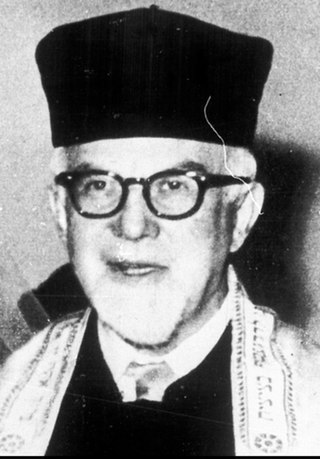
Adolf Kober was a rabbi and a historian.
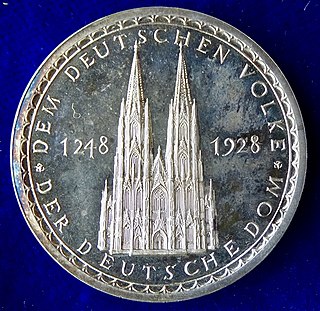
Meister or Master Gerhard was the first master mason of Cologne Cathedral. He was also known as Gerhard von Rile or by the Latin version of his name, Meister Gerardus.

The Altenberger Dom is the former abbey church of Altenberg Abbey which was built from 1259 in Gothic style by Cistercians. Listed as a cultural heritage, it is located in Altenberg, now part of Odenthal in the Rheinisch-Bergischer Kreis, North Rhine-Westphalia, Germany. Until 1511, the church was the burial site of counts and dukes of Berg and the dukes of Jülich-Berg.

The Dombild Altarpiece is a painted triptych by the German 15th-century artist Stefan Lochner. Originally painted for the council-chapel St. Maria in Jerusalem in Cologne, it was moved to Cologne Cathedral in 1810 and is now in that church's Marienkapelle, south of the choir. It is also known as the Three Kings Altarpiece (Dreikönigsaltar) and the Patron Saints of Cologne Altarpiece.
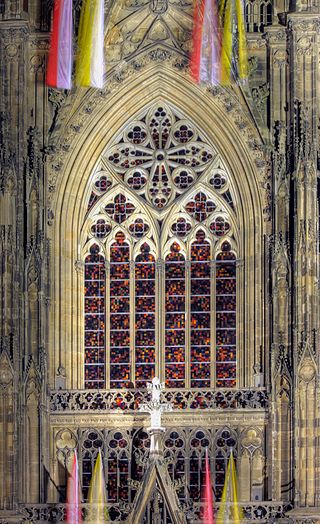
The Cologne Cathedral Window is the stained glass window in the south transept of the Cologne Cathedral designed by Cologne artist Gerhard Richter. On a surface of 106 square metres 11.263 glass squares in 72 colours of 9,6 cm × 9.6 cm were principally arranged randomly, with others selected in response to architectural context. The window was inaugurated on 25 August 2007 as part of a Eucharistic celebration; the abstract execution was both celebrated and strongly criticized.
David Levi Elkan (1808-1865) was a Jewish German engraver.
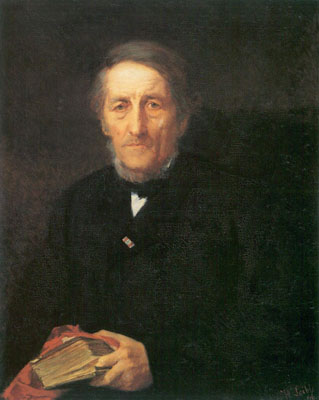
Carl (Karl) Leibl was a German musician, conductor, cathedral organist and cathedral conductor in Cologne.
Eberhard Metternich is a German catholic church musician, school musician, singer, cathedral kapellmeister and professor for choral conducting in Cologne.
Willy Weyres was a German architect and academic teacher. He was Kölner Dombaumeister from 1944 to 1972, diocesan master builder for the Archdiocese of Cologne for more than ten years, and full professor of architectural history and monument preservation at the RWTH Aachen from 1955 until his retirement in 1972. Under his leadership, the Cologne Cathedral was restored and further developed after the Second World War.

The Cologne Cathedral quarter is the area immediately surrounding Cologne Cathedral in Cologne, North Rhine-Westphalia, Germany. When the Gothic cathedral was built, it was closely surrounded by houses and smaller churches. When the cathedral was completed in 1880 as a national symbol, it was freed from adjacent structures and stood isolated, unhampered by traffic. After the inner city was destroyed in World War II, it was rebuilt, with a pedestrian area connecting to the cathedral. In 1970, the Domplatte was constructed as a large concrete surface without steps around the cathedral, which became the location of major open-air events such as Carnival and pop concerts. The design of the cathedral surroundings has remained a challenge for urban planning.

Arnold Wolff was a German architect. He was Cologne Cathedral Master Builder and head of the Dombauhütte of the Cologne Cathedral from 1972 to 1998. From 1986 to 1997, he was academic teacher for restoration and conservation at the Cologne University of Applied Sciences.
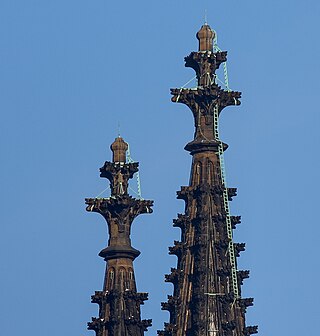
The finials of Cologne Cathedral form the tops of the two towers at a height of 149 to 157 metres. A copy of this finial in original size, but made of concrete, has stood below the steps in front of the west façade of the cathedral since 1991.
The Taubenbrunnen is a fountain sculpture designed by Ewald Mataré and erected in 1953 in the Altstadt-Nord district of Cologne, situated directly in front of the west side of the Cologne Cathedral.
Lisamaria Meirowsky was a German dermatologist and pediatrician murdered by the Nazis because of her Jewish heritage.
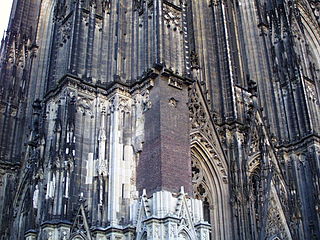
The Cologne Cathedral Seal was a section of unclad brickwork which covered destroyed masonry on an exterior pillar of Cologne Cathedral. In November 1943, during an air raid by the allies, a bomb seriously damaged a pillar on the northern tower of the cathedral, sparking fears for the structural integrity of the surrounding parts of the building. The missing sandstone was replaced with bricks by the spring of 1944, which remained visible on the north tower for over 60 years. As the last major war damage, the seal was repaired between 1995 and 2005 and faced with cut stone. Some experts had argued that the seal should be left undisguised as an anti-war memorial.
